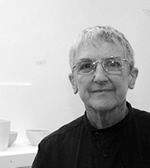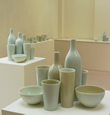GWYN HANSSEN PIGOTT
9 June - 8 July 2010

In a career spanning 50 years, Gwyn Hanssen Pigott, has consistently pursued a ‘truth’ of form. Her motivation, inspired by such iconic potters as Bernard Leach and Lucie Rie, found direction through modernist still life painting, particularly the formal arrangements of Giorgio Morandi. She has subsequently evolved ‘inseparable’ groups of translucent porcelain bottles, bowls, jugs and cups which explore the physical and psychological potential of the pot to its fullest extent.
Harmonising a restrained, modulated palette with the simplicity of form, each grouping conveys a powerful sense of the tribe or family. Arranged in ‘clusters’ or rhythmic procession, a sense of cohesion or passage is invoked by her ever-inquisitive repetition of design and acute awareness of spatial balance.
When exhibiting at Tate St Ives, Hanssen Pigott’s vocabulary resonated happily with the Modern-style architecture of the building and the natural green/greys and Naples yellow of Porthmeor Beach that flood the sea-facing gallery. In the 55ft showcase, the luminescent properties of her material, as always, brought an innate vitality to her work - a quality that the abstract sculptor Barbara Hepworth both revered and exploited in her use of Italian marble in the Cornish light.
Perhaps more pertinently, like Hepworth, she brings an enduring nobility to her simple forms by virtue of her laborious hand paring of their bodies and burnishing of their surfaces: physical and intellectual physical and intellectual connection ensues. The works engage us because they reflect an approach to life, a tenacity, a patience of mind and a universal humanism that is often overlooked in the frenetic demands of daily existence. These quiet meditations into the beauty of domestic vessels indeed captivate and impel the viewer far beyond the day-to-day.
Sara Hughes, Curator, Tate St. Ives
Bottles, bowls and beakers – a way of seeing.
Downstairs at the National Gallery of Australia there is a square pond. In it, carefully sited, are two soaring sculptures by Constantin Brancusi, one of black and one of white marble: each a Bird in Space. Walk around it, slowly. At one point of travel the white bird is gone – and only the black remains. Continue then, welcome back the white, and see the black almost disappear: a private delight.
And so, I hope, the bottles and bowls and beakers in the clusters huddle, then merge or disappear, then open out, as we move around them. Looking. Playing.
Gwyn Hanssen Pigott

















